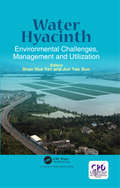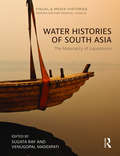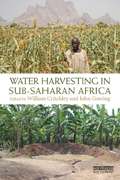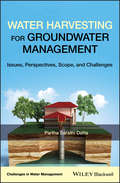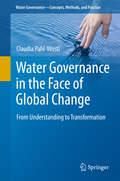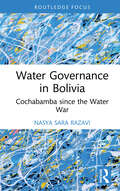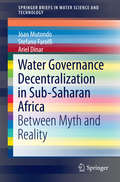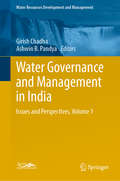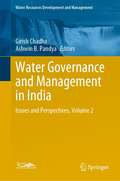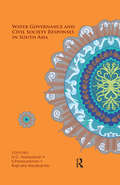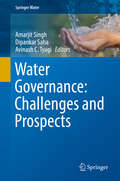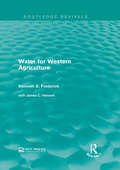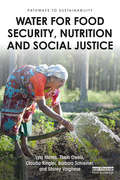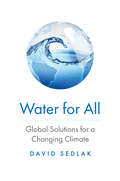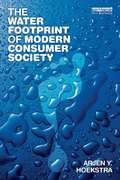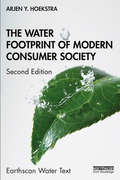- Table View
- List View
Water Hyacinth: Environmental Challenges, Management and Utilization
by Shao Hua Yan Jun Yao GuoThe water hyacinth is a disruptive factor in aquatic ecosystem management and ecosystem services, and causes problems in fisheries, transportation waterways, irrigation, hydropower generation, and water resources. To address these concerns, it is necessary to integrate past studies with current research and innovations to identify where the knowledge gap is and to creatively assess and solve the problems in a global context. This book provides comprehensive coverage of new research and technological innovations for the application of controlling, managing, harvesting, postharvest processing and utilizing the water hyacinth.
Water Hyacinth: Environmental Challenges, Management and Utilization
by Shaohua Yan Jun Yao GuoThe water hyacinth is a disruptive factor in aquatic ecosystem management and ecosystem services, and causes problems in fisheries, transportation waterways, irrigation, hydropower generation, and water resources. To address these concerns, it is necessary to integrate past studies with current research and innovations to identify where the knowledge gap is and to creatively assess and solve the problems in a global context. This book provides comprehensive coverage of new research and technological innovations for the application of controlling, managing, harvesting, postharvest processing and utilizing the water hyacinth.
Water Histories of South Asia: The Materiality of Liquescence (Visual and Media Histories)
by Sugata Ray Venugopal MaddipatiThis book surveys the intersections between water systems and the phenomenology of visual cultures in early modern, colonial and contemporary South Asia. Bringing together contributions by eminent artists, architects, curators and scholars who explore the connections between the environmental and the cultural, the volume situates water in an expansive relational domain. It covers disciplines as diverse as literary studies, environmental humanities, sustainable design, urban planning and media studies. The chapters explore the ways in which material cultures of water generate technological and aesthetic acts of envisioning geographies, and make an intervention within political, social and cultural discourses. A critical interjection in the sociologies of water in the subcontinent, the book brings art history into conversation with current debates on climate change by examining water’s artistic, architectural, engineering, religious, scientific and environmental facets from the 16th century to the present. This is one of the first books on South Asia’s art, architecture and visual history to interweave the ecological with the aesthetic under the emerging field of eco art history. The volume will be of interest to scholars and general readers of art history, Islamic studies, South Asian studies, urban studies, architecture, geography, history and environmental studies. It will also appeal to activists, curators, art critics and those interested in water management.
Water Histories of South Asia: The Materiality of Liquescence (Visual and Media Histories)
by Sugata Ray Venugopal MaddipatiThis book surveys the intersections between water systems and the phenomenology of visual cultures in early modern, colonial and contemporary South Asia. Bringing together contributions by eminent artists, architects, curators and scholars who explore the connections between the environmental and the cultural, the volume situates water in an expansive relational domain. It covers disciplines as diverse as literary studies, environmental humanities, sustainable design, urban planning and media studies. The chapters explore the ways in which material cultures of water generate technological and aesthetic acts of envisioning geographies, and make an intervention within political, social and cultural discourses. A critical interjection in the sociologies of water in the subcontinent, the book brings art history into conversation with current debates on climate change by examining water’s artistic, architectural, engineering, religious, scientific and environmental facets from the 16th century to the present. This is one of the first books on South Asia’s art, architecture and visual history to interweave the ecological with the aesthetic under the emerging field of eco art history. The volume will be of interest to scholars and general readers of art history, Islamic studies, South Asian studies, urban studies, architecture, geography, history and environmental studies. It will also appeal to activists, curators, art critics and those interested in water management.
Water Harvesting in Sub-Saharan Africa
by William Critchley John GowingAgriculture in Sub-Saharan Africa is constrained by highly variable rainfall, frequent drought and low water productivity. There is an urgent need, heightened by climate change, for appropriate technologies to address this problem through managing and increasing the quantity of water on farmers’ fields – water harvesting. This book defines water harvesting as a set of approaches which occupy an intermediate position along the water-management spectrum extending from in situ moisture conservation to irrigated agriculture. They generally comprise small-scale systems that induce, collect, store and make use of local surface runoff for agriculture. The authors review development experience and set out the state of the art of water harvesting for crop production and other benefits in Sub-Saharan Africa. This includes an assessment of water harvesting schemes that were initiated two or three decades ago when interest was stimulated by the droughts of the 1970s and 1980s. These provide lessons to promote sustainable development of dryland agriculture in the face of changing environmental conditions. Case studies from eight countries across Sub-Saharan Africa provide the evidence base. Each follows a similar format and is based on assessments conducted in collaboration with in-country partners, with a focus on attempts to promote adoption of water harvesting, both horizontally (spread) and vertically (institutionalization). Introductory cross-cutting chapters as well as an analytical conclusion are also included.
Water Harvesting in Sub-Saharan Africa
by William Critchley John GowingAgriculture in Sub-Saharan Africa is constrained by highly variable rainfall, frequent drought and low water productivity. There is an urgent need, heightened by climate change, for appropriate technologies to address this problem through managing and increasing the quantity of water on farmers’ fields – water harvesting. This book defines water harvesting as a set of approaches which occupy an intermediate position along the water-management spectrum extending from in situ moisture conservation to irrigated agriculture. They generally comprise small-scale systems that induce, collect, store and make use of local surface runoff for agriculture. The authors review development experience and set out the state of the art of water harvesting for crop production and other benefits in Sub-Saharan Africa. This includes an assessment of water harvesting schemes that were initiated two or three decades ago when interest was stimulated by the droughts of the 1970s and 1980s. These provide lessons to promote sustainable development of dryland agriculture in the face of changing environmental conditions. Case studies from eight countries across Sub-Saharan Africa provide the evidence base. Each follows a similar format and is based on assessments conducted in collaboration with in-country partners, with a focus on attempts to promote adoption of water harvesting, both horizontally (spread) and vertically (institutionalization). Introductory cross-cutting chapters as well as an analytical conclusion are also included.
Water Harvesting for Groundwater Management: Issues, Perspectives, Scope, and Challenges (Challenges in Water Management Series)
by Partha Sarathi DattaOutlines the concept and principles of water harvesting for groundwater management for an international audience, and looks at the positives and negatives surrounding water harvesting technologies This book is the first to fully outline the concept and principles of water harvesting for groundwater management for a global audience. It offers guidance to academics, students and researchers on effective water harvesting approaches for groundwater recharge, and educates them on the risks associated with managed aquifer recharge, as well as the causes of success or failure of particular management strategies, and demand management strategies and tools. The book is helpful to water managers, administrators, and professionals, to make decisions to allocate resources; developing innovative cost-effective measures and approaches to achieve demand-supply balance. The book provides readers with an overview of the historical evolution of water harvesting for groundwater recharge. It looks at the benefits and gaps in knowledge, their implementation and funding strategies, and public participation. It also assesses the strengths, weaknesses, opportunities, and threats (SWOT) of water harvesting technologies. Water Harvesting for Groundwater Management: Issues, Perspectives, Scope and Challenges offers chapters covering: issues on water harvesting and water security; mega-trends that impact water security; groundwater occurrence, availability, and recharge-ability; phases of water harvesting systems; SWOT analysis of water harvesting systems; case studies and short examples of implementing water harvesting; scope of water harvesting for GWM strategies; guidelines to make water harvesting helpful and meaningful for GWM; and more. Summarizes the theories and applications of water harvesting for groundwater management for a world audience Offers guidance on effective water harvesting approaches for groundwater recharge, managed aquifer recharge, and successful water management strategies Evaluates the strengths, weaknesses, opportunities and threats (SWOT) of water harvesting technologies Part of the Challenges in Water Management series Water Harvesting for Groundwater Management: Issues, Perspectives, Scope and Challenges is an excellent resource for water management professionals working with water harvesting technologies, and will be of great interest to water managers, administrators, professionals, academics and researchers working in water management.
Water Harvesting for Groundwater Management: Issues, Perspectives, Scope, and Challenges (Challenges in Water Management Series)
by Partha Sarathi DattaOutlines the concept and principles of water harvesting for groundwater management for an international audience, and looks at the positives and negatives surrounding water harvesting technologies This book is the first to fully outline the concept and principles of water harvesting for groundwater management for a global audience. It offers guidance to academics, students and researchers on effective water harvesting approaches for groundwater recharge, and educates them on the risks associated with managed aquifer recharge, as well as the causes of success or failure of particular management strategies, and demand management strategies and tools. The book is helpful to water managers, administrators, and professionals, to make decisions to allocate resources; developing innovative cost-effective measures and approaches to achieve demand-supply balance. The book provides readers with an overview of the historical evolution of water harvesting for groundwater recharge. It looks at the benefits and gaps in knowledge, their implementation and funding strategies, and public participation. It also assesses the strengths, weaknesses, opportunities, and threats (SWOT) of water harvesting technologies. Water Harvesting for Groundwater Management: Issues, Perspectives, Scope and Challenges offers chapters covering: issues on water harvesting and water security; mega-trends that impact water security; groundwater occurrence, availability, and recharge-ability; phases of water harvesting systems; SWOT analysis of water harvesting systems; case studies and short examples of implementing water harvesting; scope of water harvesting for GWM strategies; guidelines to make water harvesting helpful and meaningful for GWM; and more. Summarizes the theories and applications of water harvesting for groundwater management for a world audience Offers guidance on effective water harvesting approaches for groundwater recharge, managed aquifer recharge, and successful water management strategies Evaluates the strengths, weaknesses, opportunities and threats (SWOT) of water harvesting technologies Part of the Challenges in Water Management series Water Harvesting for Groundwater Management: Issues, Perspectives, Scope and Challenges is an excellent resource for water management professionals working with water harvesting technologies, and will be of great interest to water managers, administrators, professionals, academics and researchers working in water management.
Water Governance in the Face of Global Change: From Understanding to Transformation (Water Governance - Concepts, Methods, and Practice)
by Claudia Pahl-WostlThis book offers the first comprehensive treatment of multi-level water governance, developing a conceptual and analytical framework that captures the complexity of real water governance systems while also introducing different approaches to comparative analysis. Applications illustrate how the ostensibly conflicting goals of deriving general principles and of taking context-specific factors into account can be reconciled. Specific emphasis is given to governance reform, adaptive and transformative capacity and multi-level societal learning. The sustainable management of global water resources is one of the most pressing environmental challenges of the 21st century. Many problems and barriers to improvement can be attributed to failures in governance rather than the resource base itself. At the same time our understanding of complex water governance systems largely remains limited and fragmented. The book offers an invaluable resource for all researchers working on water governance topics and for practitioners dealing with water governance challenges alike.
Water Governance in Bolivia: Cochabamba since the Water War (Routledge Focus on Environment and Sustainability)
by Nasya Sara RazaviThis book examines water remunicipalization in Cochabamba since the Water War, offering innovative methodological and theoretical conceptualizations of what it means to be "public," helping to move debates on water services beyond the paralyzing binary of public versus private with a focus on the contested terrain of community engagement around water services. The Cochabamba Water War of 2000 brought together city residents of all stripes to mobilize against water privatization and gain back public control of the city’s water utility. This event catapulted anti-privatization movements around the world, but two decades later, the water movement’s vision of democratic water provision remains largely unfulfilled and the city suffers from a protracted water crisis. Building a typology of participation, this book explores the difficulty in rebuilding a strong public water service in Cochabamba by analyzing the different, and often incompatible, understandings and interpretations of social control and public participation. Applying this framework to the Bolivian context, and more specifically to the water and sanitation sector in Cochabamba, the book uncovers whose interests are served, and which groups are included or excluded from decision-making and access to water. This exercise illustrates how, in their implementation, participatory practices are not linear and can be distorted or appropriated towards different ends. This book will be of great interest to students and scholars of water governance, natural resource management, public policy, social movements and Latin American studies.
Water Governance in Bolivia: Cochabamba since the Water War (Routledge Focus on Environment and Sustainability)
by Nasya Sara RazaviThis book examines water remunicipalization in Cochabamba since the Water War, offering innovative methodological and theoretical conceptualizations of what it means to be "public," helping to move debates on water services beyond the paralyzing binary of public versus private with a focus on the contested terrain of community engagement around water services. The Cochabamba Water War of 2000 brought together city residents of all stripes to mobilize against water privatization and gain back public control of the city’s water utility. This event catapulted anti-privatization movements around the world, but two decades later, the water movement’s vision of democratic water provision remains largely unfulfilled and the city suffers from a protracted water crisis. Building a typology of participation, this book explores the difficulty in rebuilding a strong public water service in Cochabamba by analyzing the different, and often incompatible, understandings and interpretations of social control and public participation. Applying this framework to the Bolivian context, and more specifically to the water and sanitation sector in Cochabamba, the book uncovers whose interests are served, and which groups are included or excluded from decision-making and access to water. This exercise illustrates how, in their implementation, participatory practices are not linear and can be distorted or appropriated towards different ends. This book will be of great interest to students and scholars of water governance, natural resource management, public policy, social movements and Latin American studies.
Water Governance Decentralization in Sub-Saharan Africa: Between Myth and Reality (SpringerBriefs in Water Science and Technology)
by Joao Mutondo Stefano Farolfi Ariel DinarThis book is about the process of water management decentralization in African countries, which is seen as a means of advancing river basin management at the lowest appropriate level. There are very different stages of implementing decentralization in practice. This called for research aiming to understand the following questions: (i) why do some water agencies succeed more than others? (ii) What are the variables involved in such reform process? (iii) which variables have a positive or a negative impact on the implementation of decentralization processes? (iv) Which variables could be affected by policy interventions, and how? This study aimed to answer these questions through the following objectives: (i) analyze the factors that have potentially affected the results of decentralization process in SSA basins, and (ii) analyze the performance of decentralization process in SSA basins. Qualitative and quantitative approaches were used. The main findings are that water scarcity is a major stimulus to reform; water user associations, if not well prepared and trained, may deter the decentralization process; and being part of an existing treaty over an international basin helps foster the process. Conditions improving decentralization performance include: scarcity of water resources, longer period of implementation, bottom-up creation, and appropriate budgetary support.
Water Governance and Management in India: Issues and Perspectives, Volume 1 (Water Resources Development and Management)
by Girish Chadha Ashwin B. PandyaThis book highlights the need for effective water governance in India given the fact that the country has been facing serious water stress in recent years. The water management in the country needs a serious scientific understanding coupled with the cooperative approach rather than a competitive one. It looks at current water regulations and underlines the need for overhaul of some laws to ensure that high water usage efficiency is attained, groundwater depletion is arrested and management of available resources is carried out in a disciplined manner. It also looks at the role of stakeholder engagement and pricing as a mechanism to manage demand in the wake of rapid population growth and industrialization.
Water Governance and Management in India: Issues and Perspectives, Volume 2 (Water Resources Development and Management)
by Girish Chadha Ashwin B. PandyaThis book, the second volume in the series, continues to raise contextual issues and presents perspectives regarding multifaceted challenges in management and governance of water in India. This volume attempts to broad base and expand the dialogue started in the first volume and would touch upon issues that need immediate discussion but have been left unattended like politics and management of groundwater, efficient utilization of water in agriculture (irrigation) and improving water use efficiency and building resilience. As in the first volume, this book presents a set of suggestions and recommendations in each chapter that can help frame policy guidelines in the country.
Water Governance and Civil Society Responses in South Asia
by N. C. Narayanan S. Parasuraman Rajindra AriyabanduThis book addresses paradigm shifts in water policy and governance, and examines the role of civil society organizations in influencing public policy, while focusing on social equity and democratic participation. It illustrates a range of interesting developments in policy formulation, donor–state nexus, and interventions by civil society and voluntary organizations. The collection of articles provides a comprehensive and current narrative of the state–society relations in South Asia under neoliberal governance reforms, their implications and key responses with regard to water policies. Using case studies, it closely investigates the impact, effectiveness, drawbacks and challenges faced by voluntary organizations and social movements working at various levels in the water sector. The work will interest researchers and students of development studies, environmental studies, natural resource management, water governance, and public administration, as also water sector professionals, policymakers, civil society activists and governmental and non-governmental organizations.
Water Governance and Civil Society Responses in South Asia
by N. C. Narayanan S. Parasuraman Rajindra AriyabanduThis book addresses paradigm shifts in water policy and governance, and examines the role of civil society organizations in influencing public policy, while focusing on social equity and democratic participation. It illustrates a range of interesting developments in policy formulation, donor–state nexus, and interventions by civil society and voluntary organizations. The collection of articles provides a comprehensive and current narrative of the state–society relations in South Asia under neoliberal governance reforms, their implications and key responses with regard to water policies. Using case studies, it closely investigates the impact, effectiveness, drawbacks and challenges faced by voluntary organizations and social movements working at various levels in the water sector. The work will interest researchers and students of development studies, environmental studies, natural resource management, water governance, and public administration, as also water sector professionals, policymakers, civil society activists and governmental and non-governmental organizations.
Water Governance: Challenges and Prospects (Springer Water)
by Amarjit Singh Dipankar Saha Avinash C. TyagiThe book is the first of its kind to deal with almost the entire swath of water resources assessment, development and sustainable management. The idea of the book crystallized during the long journey of the Editors on various facets of water issues in India and abroad during their extended association, at all levels with the Ministry of Water Resources, River Development and Ganga Rejuvenation, as well as International Organizations dealing with water. Currently water-stressed, India is likely to become water scarce in not too distant a future. The global freshwater supply and its sustainable use for human consumption, and conservation of the ecosystem have never come under such a rigorous scrutiny before. The unplanned and reckless exploitation of this precious resource have led to a crisis situation, compounded by a real threat of climate change. This book is, therefore, timely and of particular relevance not only to India but the entire world. The book contains 20 chapters, beside the lead article by the Editors. The chapters are contributed by the eminent professionals, researchers, academicians and civil society representatives having an in-depth understanding of the issues. The contents of the chapters have been chosen to represent all aspects of water. The assessment of water resources using satellite data and in-depth analyses of groundwater sector like, the Aquifer Mapping Programme initiated by Government of India, application of gravity satellite data to assess the resource build up, artificial recharge of aquifers and its contamination, are dealt with by eminent experts. The articles on sustainable management of water through good governance by community participation and involvement of civil society are placed. Flood management both through a basin level approach as well as by building resilience in vulnerable areas is discussed. Other critical issues like water bodies management, constitutional provisions, water governance and financial issues, hydro-power and need of research and development in this sector are also dealt with aptly. In view of emerging crisis and complexities in this sector the future pathways and the paradigm shift that is required in administrative and policy level is also discussed.
Water for Western Agriculture (Routledge Revivals)
by Kenneth D. FrederickThis title, originally published in 1982, examines the importance of western irrigation to U.S. agriculture and the impacts of the changing water supply situation on the development of western irrigation. Past trends, water supply conditions, water institutions, economic forces, technological alternatives, and environmental factors are examined for their impacts on the course of western irrigation. Water for Western Agriculture will be of particular interest for students studying environmental issues.
Water for Western Agriculture (Routledge Revivals)
by Kenneth D. FrederickThis title, originally published in 1982, examines the importance of western irrigation to U.S. agriculture and the impacts of the changing water supply situation on the development of western irrigation. Past trends, water supply conditions, water institutions, economic forces, technological alternatives, and environmental factors are examined for their impacts on the course of western irrigation. Water for Western Agriculture will be of particular interest for students studying environmental issues.
Water for Food Security, Nutrition and Social Justice (Pathways to Sustainability)
by Lyla Mehta Theib Oweis Claudia Ringler Barbara Schreiner Shiney VargheseThis book is the first comprehensive effort to bring together Water, Food Security and Nutrition (FSN) in a way that goes beyond the traditional focus on irrigated agriculture. Apart from looking at the role of water and sanitation for human well-being, it proposes alternative and more locally appropriate ways to address complex water management and governance challenges from the local to global levels against a backdrop of growing uncertainties. The authors challenge mainstream supply-oriented and neo-Malthusian visions that argue for the need to increase the land area under irrigation in order to feed the world’s growing population. Instead, they argue for a reframing of the debate concerning production processes, waste, food consumption and dietary patterns whilst proposing alternative strategies to improve water and land productivity, putting the interests of marginalized and disenfranchized groups upfront. The book highlights how accessing water for FSN can be challenging for small-holders, vulnerable and marginalized women and men, and how water allocation systems and reform processes can negatively affect local people’s informal rights. The book argues for the need to improve policy coherence across water, land and food and is original in making a case for strengthening the relationship between the human rights to water and food, especially for marginalized women and men. It will be of great interest to practitioners, students and researchers working on water and food issues.
Water for Food Security, Nutrition and Social Justice (Pathways to Sustainability)
by Lyla Mehta Theib Oweis Claudia Ringler Barbara Schreiner Shiney VargheseThis book is the first comprehensive effort to bring together Water, Food Security and Nutrition (FSN) in a way that goes beyond the traditional focus on irrigated agriculture. Apart from looking at the role of water and sanitation for human well-being, it proposes alternative and more locally appropriate ways to address complex water management and governance challenges from the local to global levels against a backdrop of growing uncertainties. The authors challenge mainstream supply-oriented and neo-Malthusian visions that argue for the need to increase the land area under irrigation in order to feed the world’s growing population. Instead, they argue for a reframing of the debate concerning production processes, waste, food consumption and dietary patterns whilst proposing alternative strategies to improve water and land productivity, putting the interests of marginalized and disenfranchized groups upfront. The book highlights how accessing water for FSN can be challenging for small-holders, vulnerable and marginalized women and men, and how water allocation systems and reform processes can negatively affect local people’s informal rights. The book argues for the need to improve policy coherence across water, land and food and is original in making a case for strengthening the relationship between the human rights to water and food, especially for marginalized women and men. It will be of great interest to practitioners, students and researchers working on water and food issues.
Water for All: Global Solutions for a Changing Climate
by David SedlakA fresh look at the world’s water crises, and the existing and emerging solutions that can be used to solve them It is not your imagination: water crises are more frequent. Our twentieth-century systems for providing the water that grows food, sustains cities, and supports healthy ecosystems are failing to meet the demands of growing population and the challenges brought on by climate change. But the grim news reports—of empty reservoirs, withering crops, failing ecosystems—need not be cause for despair, argues award-winning author David Sedlak. Communities on the front lines of previous water crises have pioneered approaches that are ready to be applied elsewhere. Some have resolved shortages by enhancing water-use efficiency, and others have used moments of crisis to resolve historic disagreements over water rights. Still others have employed treatment technologies that unlock vast quantities of untapped water resources. Sedlak identifies the challenges that society faces, including ineffective policies and outdated infrastructure, and the myriad of tools at our disposal—from emerging technologies in desalination to innovations for recycling wastewater and capturing more of the water that falls on fields and cities. He offers an informed and hopeful approach for rethinking our assumptions about the way that water is managed. With this knowledge we can create a future with clean, abundant, and affordable water for all.
The Water Footprint of Modern Consumer Society
by Arjen Y. HoekstraWater is not only used in the domestic context, but also in agriculture and industry in the production of commercial goods, from food to paper. The water footprint is an indicator of freshwater use that looks at both direct and indirect use of water by a consumer or producer. The water footprint of an individual, community or business is defined as the total volume of freshwater that is used to produce the goods and services consumed by the individual or community or produced by the business. This book shows how the water footprint concept can be used to quantify and map the water use behind consumption and how it can guide reduction of water use to a sustainable level. With a number of case studies, it illustrates water use along supply chains and that water consumption at one place is often linked to water use at another. For example, it is calculated that it takes 15,000 litres of water to produce 1 kg of beef, or 8,000 litres of water to produce a pair of jeans. The book shows that imports of water-intensive products can highly benefit water-scarce countries, but also that this creates a dependency on foreign water resources. The book demonstrates how water-scarce regions sometimes, nevertheless, use lots of water for making export products. It raises the issue of sustainable consumption: how can consumers, businesses and governments get involved in reducing the water footprints of final consumer goods?
The Water Footprint of Modern Consumer Society
by Arjen Y. HoekstraWater is not only used in the domestic context, but also in agriculture and industry in the production of commercial goods, from food to paper. The water footprint is an indicator of freshwater use that looks at both direct and indirect use of water by a consumer or producer. The water footprint of an individual, community or business is defined as the total volume of freshwater that is used to produce the goods and services consumed by the individual or community or produced by the business. This book shows how the water footprint concept can be used to quantify and map the water use behind consumption and how it can guide reduction of water use to a sustainable level. With a number of case studies, it illustrates water use along supply chains and that water consumption at one place is often linked to water use at another. For example, it is calculated that it takes 15,000 litres of water to produce 1 kg of beef, or 8,000 litres of water to produce a pair of jeans. The book shows that imports of water-intensive products can highly benefit water-scarce countries, but also that this creates a dependency on foreign water resources. The book demonstrates how water-scarce regions sometimes, nevertheless, use lots of water for making export products. It raises the issue of sustainable consumption: how can consumers, businesses and governments get involved in reducing the water footprints of final consumer goods?
The Water Footprint of Modern Consumer Society (Earthscan Water Text)
by Arjen Y. HoekstraUsing the water footprint concept, this impactful book aids our understanding of how we can reduce water consumption and pollution to sustainable levels. Since the publication of the first edition, the question of how to reduce our water footprint has become even more urgent. Freshwater scarcity is increasingly perceived as a global systemic risk and overconsumption of water is widespread. The water footprint, a concept founded by the author, is an indicator of direct and indirect freshwater use by a consumer or producer that can be used to analyze water usage along supply chains and assess the sustainability, efficiency and fairness of our water use. This new edition is fully revised and updated to reflect continued developments in this rapidly growing field of knowledge. New chapters are added covering the history of the water footprint concept; the environmental footprint of the human species versus planetary boundaries; and the human right to water as a foundation to equitable sharing. All other chapters are fully revised with new findings, applications and references, including major new research on energy, vegetarian diets and intelligent water allocation over competing demands. The Water Footprint of Modern Consumer Society is a key textbook for students of interdisciplinary water studies and those taking other related courses within the environmental sciences. It will also be of interest to those working in the governmental sector, environmental and consumer organizations, the business sector and UN institutions, where there is growing interest in the water footprint concept.
